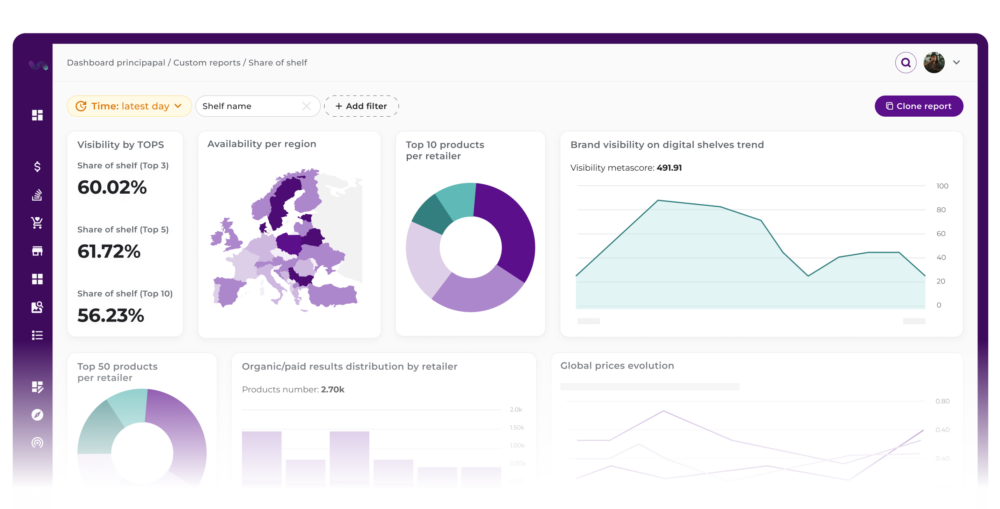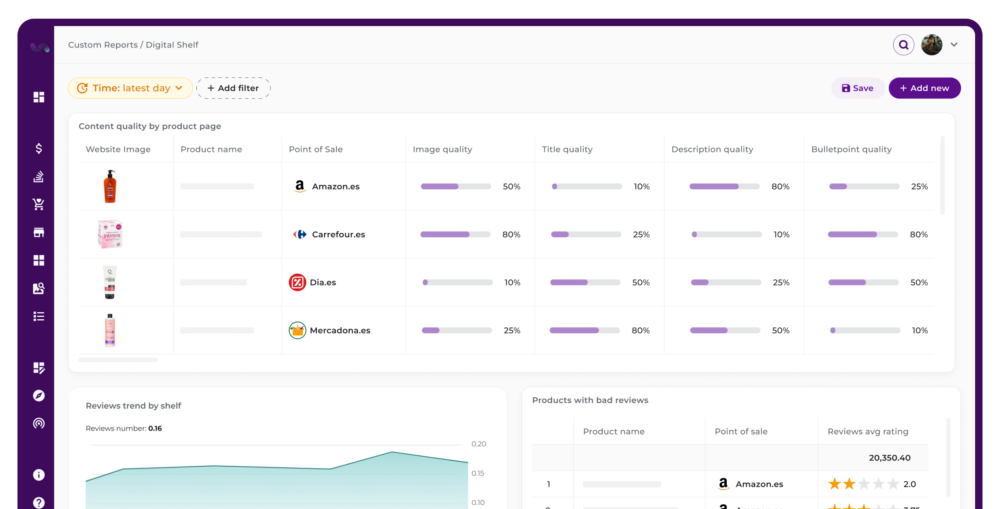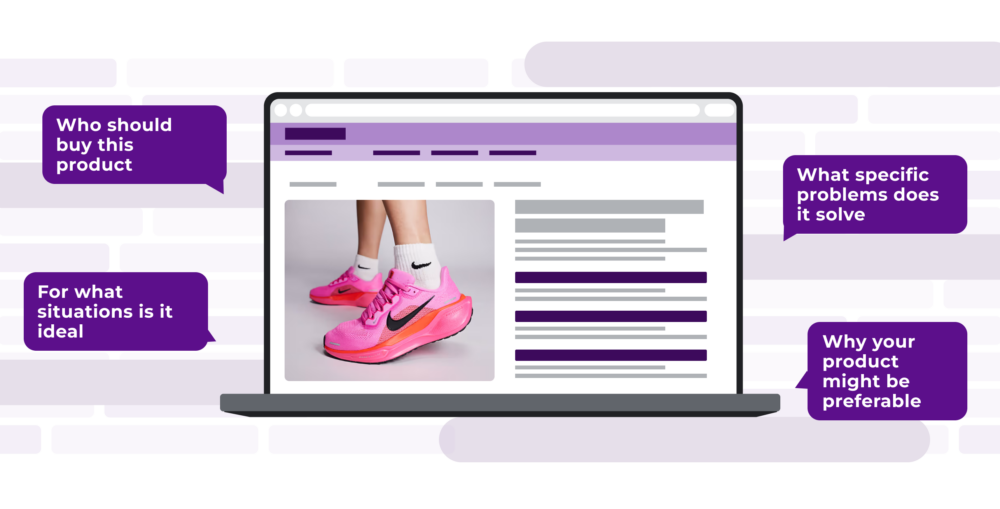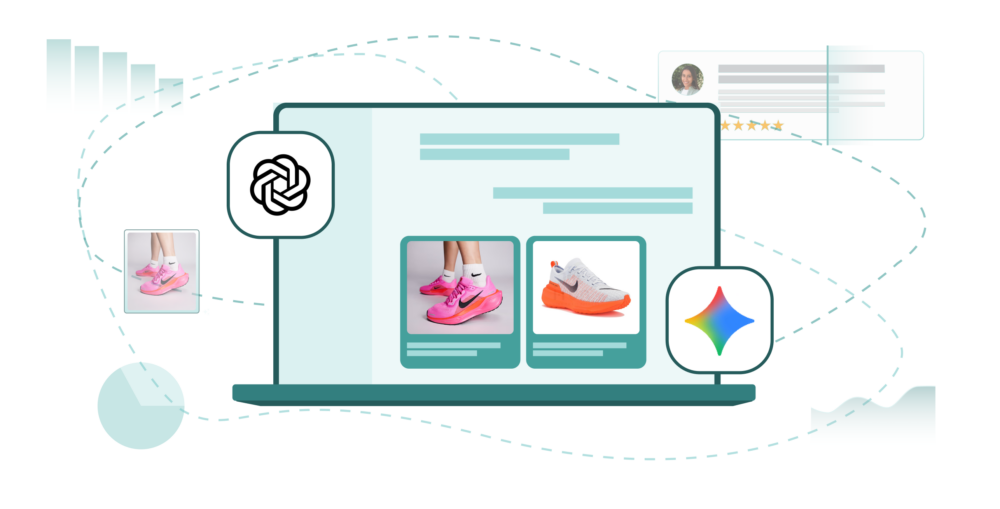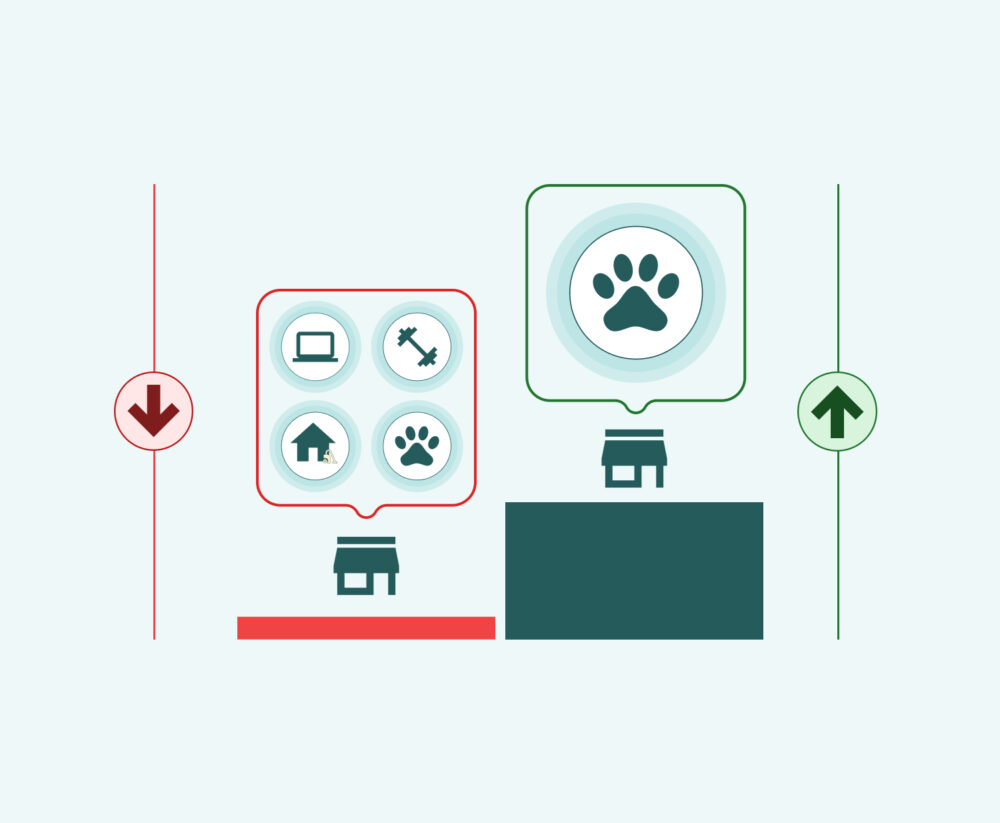From PDP to Prompt: How Digital Shelf Analytics Puts You on the LLM Radar
The customer journey to a product no longer runs solely through a results page: increasingly, it happens via conversational responses. According to a recent study by Salesforce, 7% of all shoppers currently start their product searches using digital AI assistants (such as ChatGPT, Perplexity or Gemini). For Gen Z consumers, this figure rises to 10%. In the last year, 17% of consumers have used an AI assistant or LLM to search for a product. The same study points out the following:
The New Way of Discovering Products
Imagine someone opening an AI assistant and typing: “I’m looking for running trainers for mild pronation, under €120, that are suitable for daily training. What do you recommend?”. That person no longer expects an endless list of links, but a clear, reasoned answer with specific models, suggested brands and, perhaps, direct links to purchase. This is the new shop window where product discovery begins.
Bing Copilot was one of the first to demonstrate this, integrating its chat experience over the Bing index and citing sources in real time. Google is following the same path with AI Overviews, which summarises information directly within the search. ChatGPT, for its part, is striking deals with big names in retail—such as Shopify or Walmart—to drive AI-powered shopping experiences, supported by Instant Checkout, its agent-based commerce protocol.
In this new scenario, visibility transcends traditional SEO or performance marketing campaigns. Being visible means being understandable, verifiable and competitive for the engines that feed language models. This is where Digital Shelf Analytics takes on a new dimension. For years, it has been used to optimise product listings, prices and reviews; today, it can also determine whether an LLM “mentions” or recommends you when someone makes a query that matches what you offer. Being well-positioned on the Digital Shelf, in a broad sense, means being on the radar for these conversational responses.
Demystifying the Key Concepts
To understand the connection between your online shop and an AI’s responses, we first need to clarify 3 fundamental concepts that we will be using constantly.
1. What is the “Digital Shelf”?
The Digital Shelf represents all the spaces on the Internet where your products are available for consumers to discover, evaluate and buy them. Think of it as the modern version of a supermarket aisle, but distributed across multiple channels: your own online shop, third-party platforms like Amazon, specialised applications, price comparison sites, and even social networks that allow direct purchases.
Each of these spaces acts as a small shop window where your product competes for the customer’s attention. Your position, the quality of your images, the completeness of your descriptions, the price you display, stock availability, and the ratings you have accumulated all make up your presence on that particular shelf. Unlike a physical shop, where space is limited and static, the digital shelf is infinite and constantly changing according to algorithms, user behaviour and your competitors’ actions.
2. What is Digital Shelf Analytics?
If the digital shelf is the space where you compete, Digital Shelf Analytics is the set of tools, metrics and processes that allow you to understand how you are doing in that competition. It involves systematically monitoring dozens of variables for each of your products on every channel where you have a presence.
These metrics include aspects like the percentage of complete content in your listings, the quality of your images, or your position in search results for key terms. They can also include real-time product availability, price comparisons with direct competitors, and the volume and quality of customer reviews. The platforms specialising in these analytics, such as flipflow, collect data from multiple sources, structure it, and present you with dashboards that reveal strengths, weaknesses and opportunities.
The power of these analytics lies in their ability to turn scattered data into actionable insights. It allows you to detect when a competitor has lowered their price just before a major campaign, identify which product attributes shoppers value most in each category, or discover that your listings on a specific channel are incomplete and this is harming your conversions.
3. How do LLMs like ChatGPT “learn”?
LLMs do not “think” or “understand” like humans. They are extremely complex mathematical models that have been trained on an unimaginable amount of text and data extracted from the internet. Their main function is to predict the next word in a sequence, which allows them to generate coherent and contextually relevant responses.
When an LLM answers a question like “recommend a product for me”, what it does is synthesise the information it has processed during its training. It looks for patterns, identifies products that are frequently mentioned in positive contexts, analyses thousands of reviews to extract key features, and values information sources it considers authoritative (expert blogs, news articles, buying guides).
This is where it all connects: a well-built and optimised Digital Shelf is a source of structured, rich and reliable data for these LLMs. Your product page is part of its study material.
Practical Guide: How to Use Digital Shelf Analytics to Get AI to Recommend You
Search Engine Optimisation (SEO) taught us to think in terms of keywords. AI Optimisation (AIO) forces us to think in terms of answers and authority. We propose a 4-step action plan to get AI to recommend your products:
Step 1: Audit your digital shelf
The first strategic move is to get an accurate picture of your current situation. You need to assess the quality and completeness of your product information on all channels where you have a presence. Use flipflow, your Digital Shelf Analytics tool, to generate a report showing what percentage of your product listings contain all the required fields.
Pay special attention to fields that are often neglected but are crucial for language models: attributes like dimensions, materials, compatibilities or certifications. This structured data helps Artificial Intelligence to understand exactly what your product is and in what contexts it is appropriate to recommend it.
Also, identify inconsistencies between channels. If your product appears with different prices on your website and on Amazon, or if the description varies substantially, you are creating confusing signals that reduce the trust an AI system can place in your information.
Step 2: Spy on your competition
Digital Shelf Analytics really shines when you use it to understand what your direct competitors are doing right. Examine how they structure their product titles, the length of their descriptions, how many images they include, which technical specifications they highlight, how they manage product variants… And, especially, what kind of language they use in their listings.
Some competitors will have discovered particularly effective ways of communicating benefits or responding to common objections that you could adapt for your own strategy.
Step 3: Optimise for questions (AIO – AI Optimisation)
The concept of AI Optimisation represents the natural evolution of search engine positioning. Before, you optimised for keywords that people typed into Google. Now you need to think about the conversational questions they might ask an AI assistant.
Instead of focusing exclusively on terms like “women’s running trainers”, consider full questions like “what trainers do you recommend for starting to run if I’m overweight?” or “I need trainers for road running that will protect my knees”. Incorporate natural answers to these types of queries into your descriptions, using language that flows organically.
Structure your product descriptions as if you were answering your customers’ most frequently asked questions. Include sections that directly address who should buy this product, for what situations it is ideal, what specific problems it solves, or why your product might be preferable in certain contexts. This structure not only improves the human user experience, it also provides the type of information a language model looks for when trying to make a contextualised recommendation.
Step 4: Actively encourage detailed reviews
Customer reviews have been important for years, but their relevance is multiplied in the context of AI. Language models analyse reviews to extract information about the product’s real-world performance, specific use cases, durability and customer service.
Implement proactive strategies to increase not only the quantity, but especially the quality of your reviews. Send follow-up emails after purchase at the optimal time, when the customer has had time to try the product but the experience is still fresh in their mind. Instead of simply asking for a rating, ask specific questions that encourage detailed answers: how they are using the product, what problem it helped them solve, what pleasantly surprised them.
Respond publicly to all reviews, both positive and negative, in a professional and helpful manner. These interactions add additional context that language models can process.
Measurement: From Digital Share of Shelf to LLM Share of Voice
Measuring the impact in this new context requires combining traditional Digital Shelf metrics with indicators that approximate your Share of Voice in LLMs. There is still no universal dashboard that tells you how many times an assistant has mentioned you. But you can observe signals and create an internal LLM monitoring system.
The concept of Share of Voice in language models measures the percentage of times that your brand or specific products appear in the response when someone asks a question related to your product category. This metric is more complex to track than traditional ones. It requires simulating user questions and analysing the responses generated by different Artificial Intelligence systems.
Some specialised agencies and tools are starting to offer this type of analysis. You can also implement a basic internal system where your team regularly asks relevant queries for your category in ChatGPT and other assistants, documenting when you appear in the recommendations, in what position, and what specific information the system uses to back up its suggestion.
Pay attention to the reasons the AI gives when it recommends your product. If it mentions specific features, particular use cases, or customer ratings, you are seeing direct evidence of which aspects of your digital presence are being processed and considered valuable. This information allows you to continually refine your content strategy.
Risks, Limits and Best Practices
Like any innovation in digital marketing, optimisation for artificial intelligence systems comes with temptations that can be counterproductive in the medium term. It is crucial to navigate this new territory with clear ethical principles and a realistic understanding of the current limitations.
Firstly, resist the temptation to artificially manipulate signals that the AI might interpret as quality indicators. Generating fake reviews, inflating product specifications, or creating multiple versions of listings with slightly different information to saturate the information space are strategies that might work for a moment but expose you to severe penalties from platforms and, fundamentally, erode the trust that is the foundation of any sustainable business.
Current language models, while impressive, have significant limitations and present certain risks:
- Hallucinations: They can sometimes invent information or attribute incorrect characteristics to a product.
- Biases: They may have a tendency to recommend larger, more established brands, as these dominate the volume of training data.
- Obsolescence: The information they were trained on may not be the most recent, which could lead to them recommending discontinued products.
The best strategy to mitigate these risks is to focus on best practices. Transparency, honesty and quality are the best defence. Ensure that all the information on your digital shelf is accurate, up-to-date and backed by an exceptional customer experience. The goal is to be such a reliable source of truth that LLMs consider you an authority in your niche.
Outlook and Future: Towards Conversational E-commerce
We are entering a new stage of e-commerce: the conversational e-commerce. Cold, purely transactional interactions are giving way to personalised, fluid dialogues, where artificial intelligence acts as an expert shopping assistant.
Although this landscape is still in its early stages, AI capabilities are advancing rapidly, and the ways in which consumers relate to it are only just beginning to take shape.
Amid all these changes, one principle remains true: the brands that generate real value, communicate it clearly, and build relationships based on trust and excellence are the ones that thrive. Technology evolves, platforms change, but deeply understanding the customer and exceptionally meeting their needs remains the key.
In this future, the Digital Shelf will no longer be just a product gallery, but will become a dynamic source of knowledge, capable of driving intelligent conversations and guiding customers towards the best decisions.
That is why optimising your product listings, collecting detailed reviews and analysing your competitive position is more important today than ever before. Every improvement to your digital shelf is a step towards a clear goal: so that when the customer of the future asks, your product is the answer.


